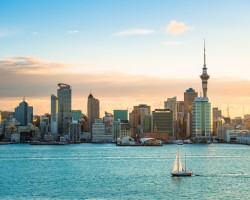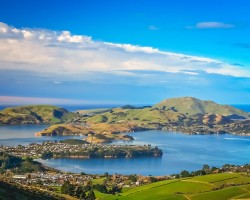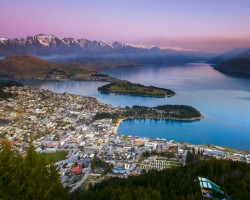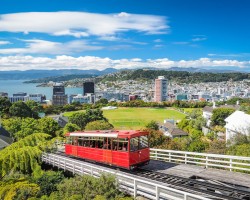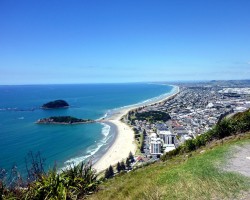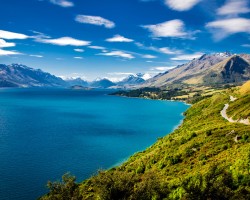Best time to go to New Zealand for a perfect weather and where to go?
When is the best time to go to New Zealand?
The best time to visit New Zealand is during the months from November to April, in summer. The weather is relatively dry and sunny with pleasant temperatures. This period corresponds to the peak tourist season. Indeed, this destination attracts holidaymakers looking to escape the winter cold.
Moreover, the highest tourist influx is observed between the last decade of December and the end of January. This period coincides with school holidays for most countries around the world. Therefore, many people take advantage of this time to spend Christmas or New Year abroad.
It is advisable to book your trip to New Zealand in advance if you are traveling during this period, as hotels and flights quickly fill up.
Furthermore, if you are wondering when to visit New Zealand to enjoy winter sports, you should look to the months from June to September. Even though the weather conditions are not ideal, with cold temperatures and abundant rainfall, winter in New Zealand is still a popular time for skiing and snowboarding enthusiasts. Indeed, the country's ski resorts are among the most renowned in the southern hemisphere.
The austral winter is also a great time for humpback whale watching in New Zealand, especially off the coast of Kaikoura.
Finally, outside of summer, some periods of the year are ideal for a stay in New Zealand. For example, in April and May or during the month of November, the climate remains pleasant in certain regions. It is therefore an ideal time to enjoy the country in a quieter atmosphere.
Where and when to go based on the weather?
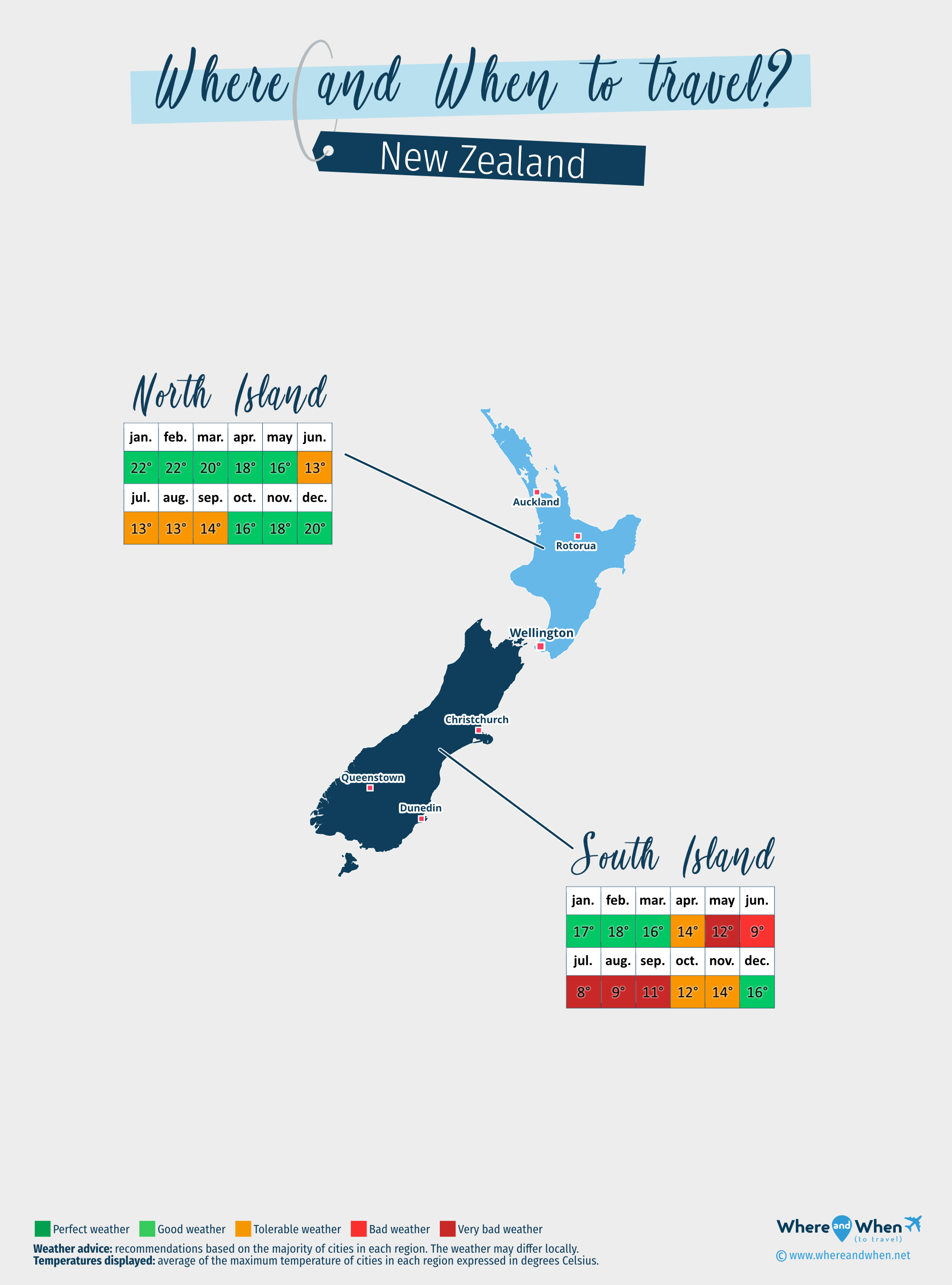
North Island
Auckland, Wellington, Rotorua...
South Island
Queenstown, Christchurch, Dunedin...
To get all the information about the climate and weather in New Zealand for a specific month, click on the corresponding link below:
New Zealand in january New Zealand in february New Zealand in march New Zealand in april New Zealand in may New Zealand in june New Zealand in july New Zealand in august New Zealand in september New Zealand in october New Zealand in november New Zealand in december
Best time to travel to New Zealand by cities
Climate and Weather in New Zealand
Located in the heart of the Pacific Ocean, not far from Australia, Fiji, and New Caledonia, New Zealand is a country made up of two main islands where you can find a multitude of volcanoes and glaciers. It is situated in the southern hemisphere and therefore experiences reversed seasons compared to Europe.
The climate in New Zealand is semi-tropical and temperate depending on the regions.
Indeed, the weather in New Zealand is influenced by the ocean as well as the Antarctic which is quite close to the southern part of the country. Thus, the South Island is particularly cold while the North Island is warmer but relatively humid. It is worth noting, however, that almost the entire territory experiences more than 2,000 hours of sunshine per year. Therefore, the climate of New Zealand is rather sunny and pleasant.

New Zealand Climate: North Island
The North Island, also known as the "smoking island," benefits from a subtropical climate, especially in its extreme north. Weather conditions can vary greatly throughout the day.
The weather is drier and sunnier in the east and south of the North Island. For example, in Wellington, the capital, there is plenty of sunshine all year round with temperatures around 20°C in summer and 12°C (54°F) in winter. However, it is best to avoid the cooler and rainier months of July and August. The capital is also located in a very windy region, which tends to affect the perceived temperatures.
Moreover, in Auckland and Hamilton, in the northern part of the island, the climate is warm and humid. In this tropical zone, rain falls throughout the year. However, it is more abundant from June to September, with around 15 rainy days per month. Nevertheless, the rainfall is not very high, reaching only 130mm per month.
Furthermore, in the north, the weather is ideal between November and April, with temperatures ranging from 15 to 25°C (77°F) . Winters enjoy a very pleasant mildness, despite frequent showers. For example, in Auckland, temperatures range between 14 and 17°C (63°F) during the months of June to October.
On the other hand, the sea temperature in this region is never very high, but swimming is possible in summer. For instance, it reaches 23°C in February in Tauranga.
New Zealand Climate: South Island
The South Island, also known as the "Jade Island," has a fairly temperate climate, but very cold in the extreme south. Experiencing four seasons in one day is not uncommon in this region as well.
This part of New Zealand is particularly dry in the east, although some humidity from the North Island can be found in certain areas.
Moreover, some regions are almost arid, such as the town of Alexandra located inland. However, this town is particularly cold with temperatures sometimes dropping below freezing in winter.
The sea temperature in this region is always cold, ranging from about 10 to 15°C (59°F) .
Climate in the West of the South Island
While precipitations are frequent throughout the year on this island, they are more abundant in the west. For example, in Westport, there are over 200 mm of precipitation from April to October. Additionally, in this town, the climate remains relatively cool all year round, with an average maximum of 20°C (68°F) in summer.
Climate in the South of the South Island
It is important to note that snow frequently falls in winter on the Jade Island, especially in the south. Cold, moisture-laden winds also make winter temperatures even more challenging. In Invercargill, for instance, freezing temperatures are common from May to September. Temperatures range from 7 to 13°C (56°F) on average during this period.
Moreover, while winter is a cold, cloudy, and relatively rainy season in this region, there are also some showers in spring and summer. October and January are, in fact, the rainiest months in the far south, unlike the rest of the island.
Between December and February, temperatures range from 12 to 18°C (65°F) on average. Therefore, there are no extreme heat waves even during the summer.
Climate in the East of the South Island
Furthermore, the east coast of the South Island, protected by mountains, experiences a different climate. The weather is drier there, and slightly warmer temperatures can be enjoyed.
For example, in the tourist city of Christchurch, temperatures range from 6 to 12°C (54°F) in winter and from 15 to 23°C (74°F) in summer. It may rain a few days per month throughout the year, but rainfall is very low. Therefore, the sun is predominantly present in this region.
Temperatures and rainfall in New Zealand
On these 3 graphs, we present the evolution of temperatures of New Zealand and month-by-month rainfall for the cities of Auckland, Christchurch, Dunedin, Queenstown and Rotorua, as well as the month-by-month sea temperature for coastal cities.

Peak visitor numbers and tourist seasons in New Zealand
Find out when New Zealand has its high tourist season (the period when the influx of tourists is highest) and off-peak tourist season using our data and figures.
Tourist seasons in New Zealand
The months with low numbers of tourists are: April, May, June, July, August, September and October. The number of visitors to New Zealand is high in: January, February, March, November and December.
- Very low season in New Zealand: May, June, July, August and September.
- Low season in New Zealand: April and October.
- High season in New Zealand: March and November.
- Peak season in New Zealand: January, February and December.
Figure: Visitor index for New Zealand month by month
Average price for flights to New Zealand
A return flight between Sydney and Auckland is generally cheaper if you go in june ($ 308 on average): this is the best time for travellers on a tight budget. In contrast, you may end up paying $ 141 more for your airline ticket to Auckland if you go in december.
Find the best price for your flight Flight prices to New Zealand
Where to go in New Zealand?
This table allows you to see the maximum temperature for each city and our opinion on the weather month by month (see colour legend below the table).
| Cities | jan. | feb. | mar. | apr. | may | jun. | jul. | aug. | sep. | oct. | nov. | dec. |
| Auckland | 74°F | 74°F | 72°F | 68°F | 63°F | 59°F | 58°F | 59°F | 59°F | 63°F | 67°F | 70°F |
| Christchurch | 72°F | 72°F | 68°F | 63°F | 58°F | 52°F | 52°F | 54°F | 58°F | 61°F | 65°F | 68°F |
| Dunedin | 61°F | 61°F | 61°F | 58°F | 54°F | 50°F | 50°F | 50°F | 52°F | 54°F | 58°F | 59°F |
| Queenstown | 67°F | 68°F | 63°F | 56°F | 50°F | 45°F | 43°F | 47°F | 50°F | 56°F | 59°F | 65°F |
| Rotorua | 74°F | 74°F | 70°F | 65°F | 59°F | 56°F | 54°F | 56°F | 59°F | 63°F | 68°F | 72°F |
| Wellington | 67°F | 67°F | 65°F | 63°F | 59°F | 56°F | 54°F | 56°F | 56°F | 58°F | 61°F | 65°F |
| Tauranga | 72°F | 72°F | 70°F | 65°F | 61°F | 58°F | 56°F | 56°F | 58°F | 61°F | 67°F | 68°F |
| Abel Tasman National Park | 67°F | 68°F | 67°F | 63°F | 61°F | 58°F | 56°F | 56°F | 58°F | 59°F | 61°F | 65°F |
| Akaroa | 72°F | 72°F | 68°F | 63°F | 58°F | 52°F | 52°F | 54°F | 58°F | 61°F | 65°F | 68°F |
| Aoraki/Mount Cook National Park | 58°F | 59°F | 58°F | 52°F | 47°F | 41°F | 40°F | 40°F | 41°F | 45°F | 50°F | 56°F |
| Cape Reinga | 72°F | 74°F | 72°F | 68°F | 65°F | 61°F | 59°F | 61°F | 61°F | 63°F | 67°F | 70°F |
| Castlepoint | 72°F | 72°F | 68°F | 65°F | 59°F | 54°F | 54°F | 56°F | 56°F | 59°F | 65°F | 68°F |
| Cathedral Cove | 72°F | 72°F | 70°F | 67°F | 63°F | 59°F | 58°F | 58°F | 59°F | 61°F | 65°F | 68°F |
| Coromandel | 72°F | 72°F | 70°F | 67°F | 63°F | 59°F | 58°F | 58°F | 59°F | 61°F | 65°F | 68°F |
| Franz Josef / Waiau | 58°F | 59°F | 58°F | 52°F | 47°F | 41°F | 40°F | 40°F | 41°F | 45°F | 50°F | 56°F |
| Haast | 65°F | 67°F | 65°F | 59°F | 56°F | 54°F | 52°F | 52°F | 54°F | 58°F | 59°F | 63°F |
| Hamilton | 76°F | 77°F | 74°F | 68°F | 63°F | 59°F | 58°F | 59°F | 61°F | 65°F | 68°F | 72°F |
| Hobbiton | 76°F | 77°F | 74°F | 68°F | 63°F | 59°F | 58°F | 59°F | 61°F | 65°F | 68°F | 72°F |
| Hokitika | 65°F | 67°F | 65°F | 61°F | 56°F | 54°F | 52°F | 54°F | 54°F | 58°F | 59°F | 63°F |
| Invercargill | 65°F | 65°F | 63°F | 59°F | 54°F | 50°F | 50°F | 52°F | 54°F | 58°F | 59°F | 63°F |
Legend:
perfect weather
good weather
tolerable weather
bad weather
very bad weather
About New Zealand
What can I do in New Zealand?
Beaches / swimming
Nature and countryside
Culture and heritage
Sports
Family travel
Crafts / shopping
Gastronomy
Nightlife
Is this weather information for New Zealand reliable?
Climate data for New Zealand has been gathered every day since January 2009. The analysis of these meteorological data for New Zealand allows us to determine the average for each month in Auckland, Christchurch, Dunedin, Queenstown, Rotorua, Wellington, Tauranga, Abel Tasman National Park, and 79 other cities.
So yes: this data is reliable except in cases of temporary climate disruption in the region.

